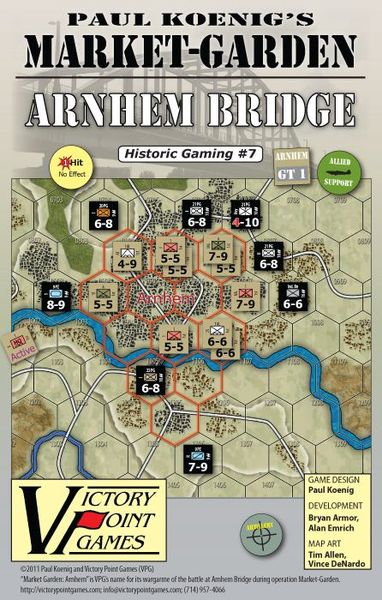Paul Koenig’s Market Garden: Arnhem Bridge (2011) Board Game
Paul Koenig’s Market Garden: Arnhem Bridge is a wargame set during World War II, specifically focusing on Operation Market Garden in September
Game Components of Paul Koenig’s Market Garden: Arnhem Bridge
How To Setup Paul Koenig’s Market Garden: Arnhem Bridge
Gameplay Mechanics and Game Objective
Players take on the roles of either the Allied or Axis forces, with the Allied player attempting to secure the bridges and the Axis player defending them. The game is played using a chit-pull system, where players draw chits randomly to determine which units can move or attack. The objective for the Allied player is to capture and hold the bridge at Arnhem, while the Axis player must prevent this from happening.
Player Experience
Pros:
Cons:
Personal Thoughts on Paul Koenig’s Market Garden: Arnhem Bridge
In my opinion, Paul Koenig’s Market Garden: Arnhem Bridge offers a unique and immersive experience for players interested in World War II history and wargames. The game’s build quality is decent, though some may find the components to be lacking compared to newer board games on the market.
The game falls into the category of wargames, which may appeal to a niche audience of strategy gamers. Pricing and availability for both new and used copies can vary, so it’s worth shopping around for the best deal.
Overall, I would recommend Paul Koenig’s Market Garden: Arnhem Bridge to fans of historical wargames who are looking for a challenging and thematic experience. However, casual gamers or those seeking more modern components may want to explore alternative options.
Game Components of Paul Koenig’s Market Garden: Arnhem Bridge
How To Setup Paul Koenig’s Market Garden: Arnhem Bridge
To set up the game, players must first place the game board on a flat surface. Each player then receives their respective unit counters and event cards. The Allied player sets up their forces according to the scenario rules, while the German player sets up their defenses. Defensive Support points are allocated to specific areas on the board to enhance defensive capabilities.
Gameplay Mechanics and Game Objective
Player Experience
**Paul Koenig’s Market Garden: Arnhem Bridge** offers a tense and strategic experience, particularly appealing to fans of historical wargames. Each game turn involves careful planning and execution, as players must balance resource management with tactical decisions. The game’s focus on a specific historical event adds a layer of realism, making it engaging for those interested in World War II history.
Pros
Cons
Personal Thoughts on Paul Koenig’s Market Garden: Arnhem Bridge
This game is ideal for enthusiasts of historical wargames and those who appreciate detailed, strategic gameplay. It is particularly suited for players who enjoy delving into the intricacies of military history and are willing to invest time in learning the game’s mechanics. While it may not be the best choice for casual gamers or large groups, it offers a deeply satisfying experience for those who enjoy tactical challenges and historical accuracy.
We are supported by our audience. When you purchase through links on our site, we may earn an affiliate commission, at no extra cost for you. Learn more.

